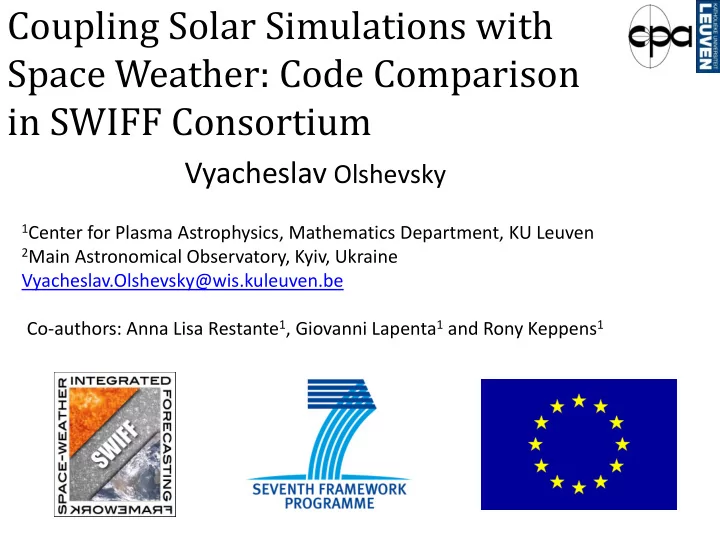

Coupling Solar Simulations with Space Weather: Code Comparison in SWIFF Consortium Vyacheslav Olshevsky 1 Center for Plasma Astrophysics, Mathematics Department, KU Leuven 2 Main Astronomical Observatory, Kyiv, Ukraine Vyacheslav.Olshevsky@wis.kuleuven.be Co-authors: Anna Lisa Restante 1 , Giovanni Lapenta 1 and Rony Keppens 1
Introduction SWIFF – S pace W eather I ntegrated F orecasting F ramework. The principal goal of SWIFF is development of mathematical models and computational methods to handle multiple physics and multiple scales of space weather. 20.06.2012 First results of SWIFF 2
Multi-physics in space weather 20.06.2012 First results of SWIFF 3
Multi-scale in space weather 20.06.2012 First results of SWIFF 4
Participants 5 scientific and 1 management work packages (WPs): • WP1. Coordination: Giovanni Lapenta , Katholieke Universiteit Leuven (KU Leuven, Belgium) • WP2. Multiscale-Multiphysics Modelling: Rony Keppens , Katholieke Universiteit Leuven (KU Leuven, Belgium) • WP3. Coupling at the Sun: Åke Nordlund , University of Copenhagen (UCPH, Denmark) • WP4. Coupling in space: Francesco Califano , Università di Pisa (UNIPISA, Italy) • WP5. Coupling at the Earth: Viviene Pierrard , Belgian Institute for Space Aeronomy (BISA, Belgium) 20.06.2012 First results of SWIFF 5
20.06.2012 First results of SWIFF 6
Numerical Codes • FlipMHD – viscous resistive MHD code (Brackbill, 1991) • MPI-AMRVAC – MPI implementation of the Versatile Advection Code with adaptive Mesh Refinement (Keppens et al 2012) • iPic3D (KU Leuven) • Stagger (UCPH, Denmark) • UNIPI two-fluid code • ASI hybrid PIC code 20.06.2012 First results of SWIFF 7
Benchmarks • Transition to turbulent reconnection (2D) • Longcope-Strauss problem (2D) • Magnetopause challenge (2D) • CME initiation challenge (3D) 20.06.2012 First results of SWIFF 8
Flux Rope Emergence Setup Semi-circular rope (Fan & Gibson 2004) 𝑪 = 𝜶 × 𝐵 𝑠 , 𝜄 𝑠 sin 𝜄 𝜒 � + 𝐶 𝜒 𝑠 , 𝜄 𝜒 � , � 2 𝑠 , 𝜄 1 𝜕 2 𝑟𝑏 2 𝐶 𝑢 exp − A 𝑠 , 𝜄 = , 𝑏 2 � 2 𝑠 , 𝜄 𝑠 sin 𝜄 exp − 𝜕 𝑏𝐶 𝑢 𝐶 𝜒 𝑠 , 𝜄 = . 𝑏 2 Embedded to the background sheared arcade (Aschwanden 2004) 𝐶 𝑦 = 𝐶 𝑦0 sin 𝑙𝑙 exp −𝑚𝑚 , 𝐶 𝑧 = 𝐶 𝑧0 sin 𝑙𝑙 exp −𝑚𝑚 , 𝐶 𝑨 = 𝐶 𝑨0 cos 𝑙𝑙 −𝑚𝑚 , 𝐶 𝑦0 = 𝑚 𝑙 𝐶 0 , 𝐶 𝑧0 = 𝛽 𝑙 𝐶 0 , 𝑙 2 − 𝑚 2 − 𝛽 2 = 0. 20.06.2012 First results of SWIFF 9
Setup Parameters 𝐶 0 = 𝑞 0 = 𝜍 0 = 1, 𝑣 0 = 0, 𝐶 𝑢 = 9 𝐶 0 , 𝑆 = 0.375, 𝑟 = − 1, 𝑏 = 0.1, 𝑀 𝑦 = 1.5, 𝑀 𝑧 = 1, 𝑀 𝑨 = 1.25, 𝑜 𝑦 = 30, 𝑜 𝑧 = 20, 𝑜 𝑨 = 25. Boundary conditions: X – open Y – periodic Top – open Bottom – constant B z 20.06.2012 First results of SWIFF 10
Results: FlipMHD No viscosity Viscous Blue represent magnetic field lines; red contour is at constant density 0.8; The grayscale on the bottom is B z . Note the destruction of density “tube” in the second case! 20.06.2012 First results of SWIFF 11
FlipMHD vs MPI-AMRVAC FlipMHD (no viscosity) MPI-AMRVAC Blue represent magnetic field lines; red contour is at constant density 0.8; The grayscale on the bottom is B z . In both cases, the tube is destroyed. The behavior of field lines is very similar. 20.06.2012 First results of SWIFF 12
Density Variation in XZ Plane 20.06.2012 First results of SWIFF 13
Results: rise of the rope 20.06.2012 First results of SWIFF 14
Conclusions The initial configuration leads to immediate emergence of the flux rope, and is handy for comparison of numerical codes The overall behavior is qualitatively the same in FlipMHD and MPI-AMRVAC simulations Rise and rotation of the flux rope is faster in the simulations of MPI-AMRVAC 20.06.2012 First results of SWIFF 15
Future? Particle-in-cell (PIC) 20.06.2012 First results of SWIFF 16
Equations of implicit moment PIC Equations of motion (moments of Vlasov) Interpolation of fields to particles Coupling of fields and particles is nonlinear: Markidis, Lapenta, Rizwan-uddin (2010), Lapenta (2012) 20.06.2012 First results of SWIFF 17
iPic3D code • Implicit time-stepping (“implicit moment method”) • Generalized Minimal Residual (GMRes) solver for the coupled equations of motion – Maxwell system • Divergence cleaning (Conjugate Gradient) – charge density continuation assurance Applications • Reconnection on the Sun; magnetosphere; anywhere • Experiments in plasma devices • Ionization of spacecrafts • PIC – hybrid and PIC – fluid coupling • Mass loss in “hot jupiters”? 20.06.2012 First results of SWIFF 18
http://www.swiff.eu 20.06.2012 First results of SWIFF 19
Annex 1. Timeline of the SWIFF project 20.06.2012 First results of SWIFF 20
Recommend
More recommend